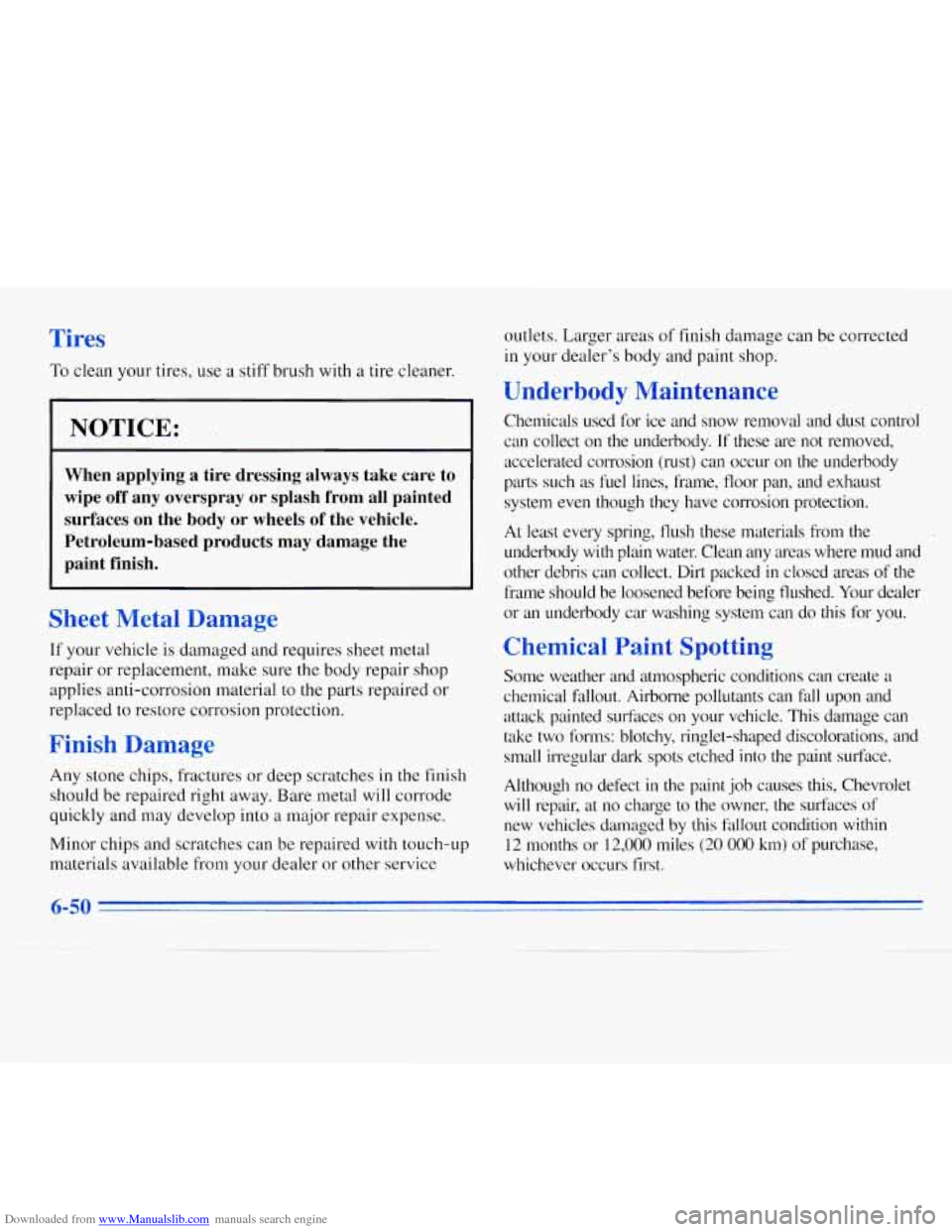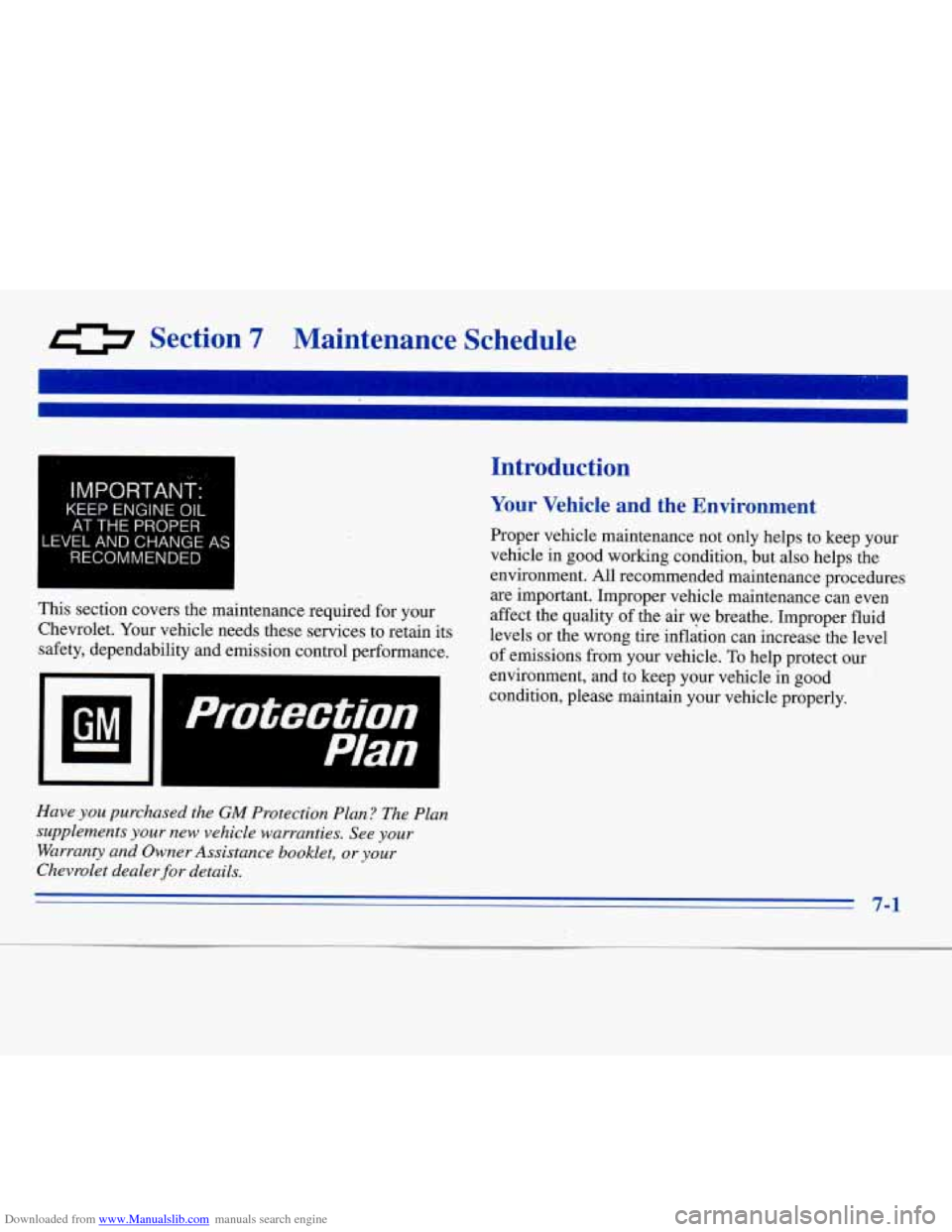1996 CHEVROLET MONTE CARLO maintenance
[x] Cancel search: maintenancePage 227 of 340

Downloaded from www.Manualslib.com manuals search engine How to Add Fluid Engine Coolant
Refer to the Maintenance Schedule to determine what
kind
of transaxle fluid to use. See “Recommended
Fluids and Lubricants”
in the Index.
If the fluid
level is low, add only enough of the proper
fluid to bring the level into the cross-hatched area on
the dipstick.
1. Pull out the dipstick.
2. Using a long-neck funnel, add enough fluid at the
dipstick hole to bring
it to the proper level. It doesn’t
take much fluid, generally less than
a pint (OSL).
Don ’t overfill. We recommend you use only fluid
labeled DEXRON@-111, because fluid with that
label is made especially for your automatic transaxle.
Damage caused by fluid other than DEXRON@-I11
is
not covered by your new vehicle warranty.
0 After adding fluid, recheck the fluid level as
described under “How to Check.”
0 When the correct fluid level is obtained, push the
dipstick back
in all the way. The cooling
system in your vehicle is filled with new
DEX-COOL
TM (orange-colored, silicate-free) engine
coolant. This coolant is designed
to remain in your
vehicle for
5 years or 100,000 miles ( 166 000 km),
whichever occurs first.
The following explains your cooling system and how
to
add coolant when it is low. If you have a problem with
engine overheating
or if you need to add coolant to your
radiator, see “Engine Overheating”
in the Index.
A 50/50 mixture of water and the proper coolant for
your Chevrolet will:
0 Give freezing protection down to -34°F (-37°C).
0 Give boiling protection up to 265°F (129°C).
Protect against rust and corrosion.
0 Help keep the proper engine temperature.
0 Let the warning lights and gages work as they
should.
Page 232 of 340

Downloaded from www.Manualslib.com manuals search engine How To Check Power Steering Fluid Windshield Washer Fluid
When the engine compartment is cool, unscrew the cap
and wipe the dipstick with a clean rag. Replace the cap
and completely tighten it. Then remove the cap, again
and look at the fluid level on the dipstick.
When the engine
compartment is hot, the
What to Use
Refer to the Maintenance Schedule to determine what
kind of fluid to use. See “Recommended Fluids and
Lubricants” in the Index. Always use the proper fluid.
Failure to use the proper fluid can cause leaks and
damage hoses and seals.
What to Use
When you need windshield washer fluid, be sure to read
the manufacturer’s instructions before use. If you will be
operating your vehicle
in an area where the temperature
may fall below freezing, use a fluid that has sufficient
protection against freezing.
Adding Washer Fluid
Open the cap labeled WASHER FLUID OmY. Add
washer fluid until the tank is full.
Page 246 of 340

Downloaded from www.Manualslib.com manuals search engine When to Check
Check your tires once a month or more.
Don’t forget your compact spare tire. It should be at
60 psi (420 kPa).
How to Check
Use a good quality pocket-type gage to check tire
pressure. You can’t tell if your tires are properly inflated
simply by looking at them. Radial tires may look
properly ‘inflated
even when they’re underinflated.
Be sure to put the valve caps back
on the valve stems.
They help prevent leaks by keeping out dirt and moisture.
Tire Inspection and Rotation
Tires should be inspected every 6,000 to 8,000 miles
(10 000 to 13 000 km) for any signs of unusual wear.
If unusual wear is present, rotate your tires as soon as
possible and check wheel alignment. Also check for
damaged tires
or wheels. See “When It’s Time for New
Tires’’ and “Wheel Replacement” later in this section for
more information. The purpose
of regular rotation
is to achieve more
uniform wear for
all tires on the vehicle. The kt
rotation is tlle most important. See “Scheduled
Maintenance Services”
in the Index for scheduled
rotation intervals.
Whcn rotating your tires,
always use the correct rotation
pattern
shown here.
Don’t include the compact spare tire
in your tire rotation.
u-30
Page 258 of 340

Downloaded from www.Manualslib.com manuals search engine Tires
To clean your tires, use a stiff brush with a tire cleaner.
NOTICE:
When applying a tire dressing always take care to
wipe off any overspray or splash from
all painted
surfaces on the body or wheels
of the vehicle.
Petroleum-based products may damage the
paint finish.
Sheet Metal Damage
If your vehicle is damaged and requires sheet metal
repair or replacement, make sure the body repair shop
applies anti-corrosion material to
the parts repaired or
replaced to restore corrosion protection.
Finish Damage
Any stone chips, fractures or deep scratches in the finish
should be repaired right away. Bare metal will corrode
quickly and may develop into
a major repair expense.
Minor chips and scratches can be repaired with touch-up
materials available from your dealer or other service outlets.
Larger areas of finish damage can be corrected
in your dealer’s body and paint shop.
Underbody Maintenance
Chemicals used for ice and snow removal and dust control
can collect on the underbody. If these are not removed,
accelerated corrosion (lust) can occur on the underbody
parts such as fuel lines, frame, floor pan, and exhaust system even though they have corrosion protection.
At least every spring, flush these materials from the
underbody with plain water. Clean
any areas where mud and
other debris can collect. Dirt packed
in closed areas of the
frame should be loosened before being flushed. Your dealer
or an underbody car washing system can do this for you.
Chemical Paint Spatting
Some weather and atmospheric conditions can create a
chemical fallout. Airborne pollutants can
fdl upon and
attack painted surfaces
on your vehicle. This damage can
take
two forms: blotchy, ringlet-shaped discolorations, and
small irregular dark spots etched into the paint surface.
Although no defect
in the paint job causes this, Chevrolet
will repair, at no charge to the owner, the surfaces of
new vehicles damaged by this fallout condition within
I2 months or 12,000 miles (20 000 kin) of purchase,
whichever occurs first.
6-50
Page 271 of 340

Downloaded from www.Manualslib.com manuals search engine Normal Maintenance Replacement Parts
Air Cleaner Filter
All Engines ........... A 1208C
Battery
3.1L (Code M) ...... 525 CCA
3.4L (Code
M) ...... 690 CCA
3.1L (Code M) ...... PF47
3.4L (Code
X) ....... PF5 1
3.1L (Code M) ...... CV892C
3.4L (Code
X) ....... CV895C
Engine Oil Filter
PCV Valve Radiator Cap
All Engines. .......... RC27
Spark Plugs
3.1L (Code M) ...... AC Type 41 -940
Gap: 0.060” ( 1.52 mm)
3.4L (Code X) ....... AC Type 41-919
Gap: 0.045”
( 1.14 mm)
Vehicle Dimensions
Wheelbase ........... 107.5” (2730 mm)
Tread Width (Front)
.... 59.5” (1 512 mm)
Tread Width (Rear)
.... 59.0” (1500 mm)
Length
.............. 200.7” (5099 mm)
Width
............... 72.5” ( 1842 mm)
Height
............... 53.8” (1 368 mm)
Air Conditioning Refrigeran
Not all air conditioning refrigerants are the same.
If the air conditioning system
in your vehicle needs
refrigerant, be sure the proper refrigerant
is used.
If you’re not sure, ask your Chevrolet dealer.
Page 273 of 340

Downloaded from www.Manualslib.com manuals search engine 0 Section 7 Maintenance Schedule
IMPORTANT:"
KEEP ENGINE OIL
AT THE
PROPER
-EVEL AND CHANGE AS
RECOMMENDED
I
Introduction
Your Vehicle and the Environment
Proper vehicle maintenance not only h,elps to keep your
vehicle in good working condition, but also helps the
environment.
All recommended maintenance procedures
are important. Improper vehicle maintenance can even
This section covers the maintenance required for your affect
the quality of the air we breathe. Improper fluid
Chevrolet. Your vehicle needs these services to retain its
levels or the wrong tire inflation can increase the level
safety, dependability and emission control performance.
of emissions from your vehicle. TO help protect our
environment, and to keep your vehicle in good
condition, please maintain your vehicle properly.
protection Plan I
Have you purchased the GM Protection Plan ? The Plan
supplements
your new vehicle warranties. See your
Warranty and Owner Assistance booklet, or your
Chevrolet dealer for details.
7-1
Page 274 of 340

Downloaded from www.Manualslib.com manuals search engine I
L
How This Section is Organized
The remainder of this section is divided into five parts:
“Part A: Scheduled Maintendnce Services”
shows what to have done and how often. Some of these
services can be complex,
so unless you are technically
qualified and have the necessary equipment, you should
let your dealer’s service department or another qualified
service center do these jobs.
Performing maintenance work on a vehicle can
be dangerous.
In trying to do some jobs, you can
be seriously injured.
Do your own maintenance
work only if you have the required know-how
and the proper tools and equipment for the job.
If you have any doubt, have a qualified
technician do the work.
11 you are skilled enough to do some work on your
vehicle, you will probably want to get the service
information
GM publishes. See “Service and Owner
Publications” in the Index.
‘Tart B: Owner Checks and Services” tells you what
should be checked whenever you stop for.
hel. It also,
explains. what you can easily do to\help keep your
vehicle in good condition.
‘Tart C: Periodic Maintenance Inspections” ’
explains important inspections that your Chevrolet
dealer’s service department
or an~ther qualified service
“center should perform.
“Part D: Recommended Fluids and LubricmtP
lists some product8 GM recommends to help keep YOLK
vehicle properly maintained. These products, or theh
equivalents, should be used whether yola do the work .
yoursel€ or have it done.
,.
“Part E: Maintenance Record” provides a place
for you to record the ‘maifltenance performed on your
vehicle. Whenever any maintenance is
performed, be
sure to; write it down in this pari. This will,help’you I
determine whin your next mainten&nce should be- done.
In addition, it
is a good idea to keep your maintenance
receipts. They may
.be needed to quahfy your vehicle for
Page 275 of 340

Downloaded from www.Manualslib.com manuals search engine Part A: Scheduled Maintenance
Services
Using Your Maintenance Schedule
We at General Motors want to help you keep your
vehicle
in good working condition. But we don’t know
exactly how you’ll drive
it. You may drive very short
distances only
a few times a week. Or you may drive
long distances all the time in very hot, dusty weather.
You may use your vehicle in making deliveries.
Or
you may drive it to work, to do errands or in many
other ways.
Because of all the different ways people use their GM
vehicles, maintenance needs vary.
You may even need
more frequent checks and replacements than you’ll find
in the schedules in this section. So please read this
section and note how you drive.
If you have any
questions
on how to keep your vehicle in good
condition, see your Chevrolet dealer.
This part tells you the maintenance services you should
have done and when you should schedule them. If you
go to your dealer for your service needs, you’ll know
that GM-trained and supported service people will
perform the work using genuine GM parts. The
proper fluids and lubricants to use are listed
in Part D.
Make sure whoever services your vehicle uses these. All
parts should be replaced and all necessaly repairs done
before you or anyone else drives
the vehicle.
These schedules are for vehicles that:
carry passengers and cargo within recommended
limits. You will find these limits on
your vehicle’s
Tire-Loading Information label. See “Loading
Your Vehicle”
in the Index.
are driven on reasonable road surfaces within legal
driving limits.
use the recommended fuel. See “Fuel” in the Index.
Selecting the Right Schedule
First you’ll need to decide which of the two schedules is
right for your vehicle. Here’s how to decide which
schedule to follow:
7-3